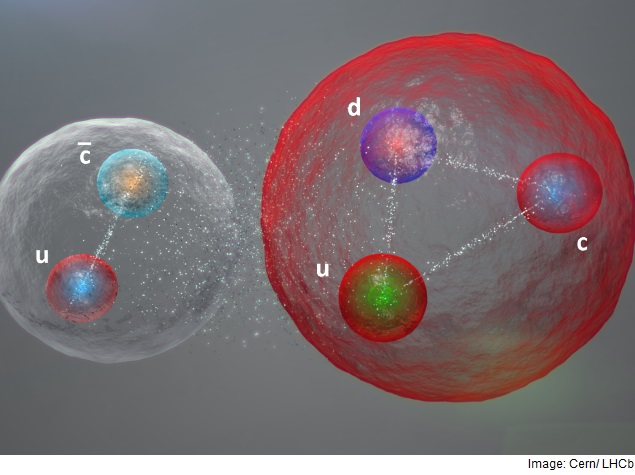- Home
- Science
- Science News
- LHC Scientists Discover New Kind of Particle: The Pentaquark
LHC Scientists Discover New Kind of Particle: The Pentaquark

Physicists had theorised the existence of the pentaquark since the 1960s, but had never been able to prove it until its detection by the LHCb experiment at the LHC, the world's most powerful particle smasher.
The discovery of the pentaquark comes after the LHC was used in 2012 to prove the existence of another particle, the Higgs Boson, which confers mass.
LHCb spokesman Guy Wilkinson said the pentaquark represented a way to combine quarks the sub-atomic particles that make up protons and neutrons "in a pattern that has never been observed before in over 50 years of experimental searches."
He added: "Studying its properties may allow us to understand better how ordinary matter, the protons and neutrons from which we're all made, is constituted."
The LHC cranked back up again in June after a two-year upgrade, with scientists hailing a "new era" in their quest to unravel more mysteries of the Universe.
The new tests at the European Organisation for Nuclear Research (Cern) have twice the energy levels they had during the last three-year experiment phase, when the existence of the Higgs Boson was confirmed.
Four laboratories are located along the LHC's ring-shaped tunnel around a hundred metres (109 yards) underground, where scientists analyse collisions between particles moving at close to the speed of light.
The LHCb, one of the four experiments, is focused on understanding the differences between matter and anti-matter and analysing certain quarks.
"Our understanding of the structure of matter was revolutionized in 1964 when American physicist, Murray Gell-Mann, proposed that a category of particles known as baryons, which includes protons and neutrons, are comprised of three fractionally charged objects called quarks," Cern said in a statement.
Gell-Mann, who won the Nobel Physics Prize in 1969, further proposed another category of particles, mesons, formed of "quark-antiquark" pairs.
His model allowed for the existence of other quark combinations such as pentaquarks, which are composed of four quarks and an antiquark. But no conclusive evidence for pentaquarks had been seen until now.
The LHCb experiment changed the game by allowing scientists to "look for pentaquarks from many perspectives", Cern said.
The findings have been submitted to the journal Physical Review Letters.
The next stage of the research will focus on studying how the quarks are bound together within the pentaquarks, the nuclear laboratory added.
Catch the latest from the Consumer Electronics Show on Gadgets 360, at our CES 2026 hub.
Related Stories
- Samsung Galaxy Unpacked 2025
- ChatGPT
- Redmi Note 14 Pro+
- iPhone 16
- Apple Vision Pro
- Oneplus 12
- OnePlus Nord CE 3 Lite 5G
- iPhone 13
- Xiaomi 14 Pro
- Oppo Find N3
- Tecno Spark Go (2023)
- Realme V30
- Best Phones Under 25000
- Samsung Galaxy S24 Series
- Cryptocurrency
- iQoo 12
- Samsung Galaxy S24 Ultra
- Giottus
- Samsung Galaxy Z Flip 5
- Apple 'Scary Fast'
- Housefull 5
- GoPro Hero 12 Black Review
- Invincible Season 2
- JioGlass
- HD Ready TV
- Laptop Under 50000
- Smartwatch Under 10000
- Latest Mobile Phones
- Compare Phones
- OPPO Reno 15 Pro Max
- Honor Win RT
- Honor Win
- Xiaomi 17 Ultra Leica Edition
- Xiaomi 17 Ultra
- Huawei Nova 15
- Huawei Nova 15 Pro
- Huawei Nova 15 Ultra
- Asus ProArt P16
- MacBook Pro 14-inch (M5, 2025)
- OPPO Pad Air 5
- Huawei MatePad 11.5 (2026)
- Xiaomi Watch 5
- Huawei Watch 10th Anniversary Edition
- Acerpure Nitro Z Series 100-inch QLED TV
- Samsung 43 Inch LED Ultra HD (4K) Smart TV (UA43UE81AFULXL)
- Asus ROG Ally
- Nintendo Switch Lite
- Haier 1.6 Ton 5 Star Inverter Split AC (HSU19G-MZAID5BN-INV)
- Haier 1.6 Ton 5 Star Inverter Split AC (HSU19G-MZAIM5BN-INV)

















